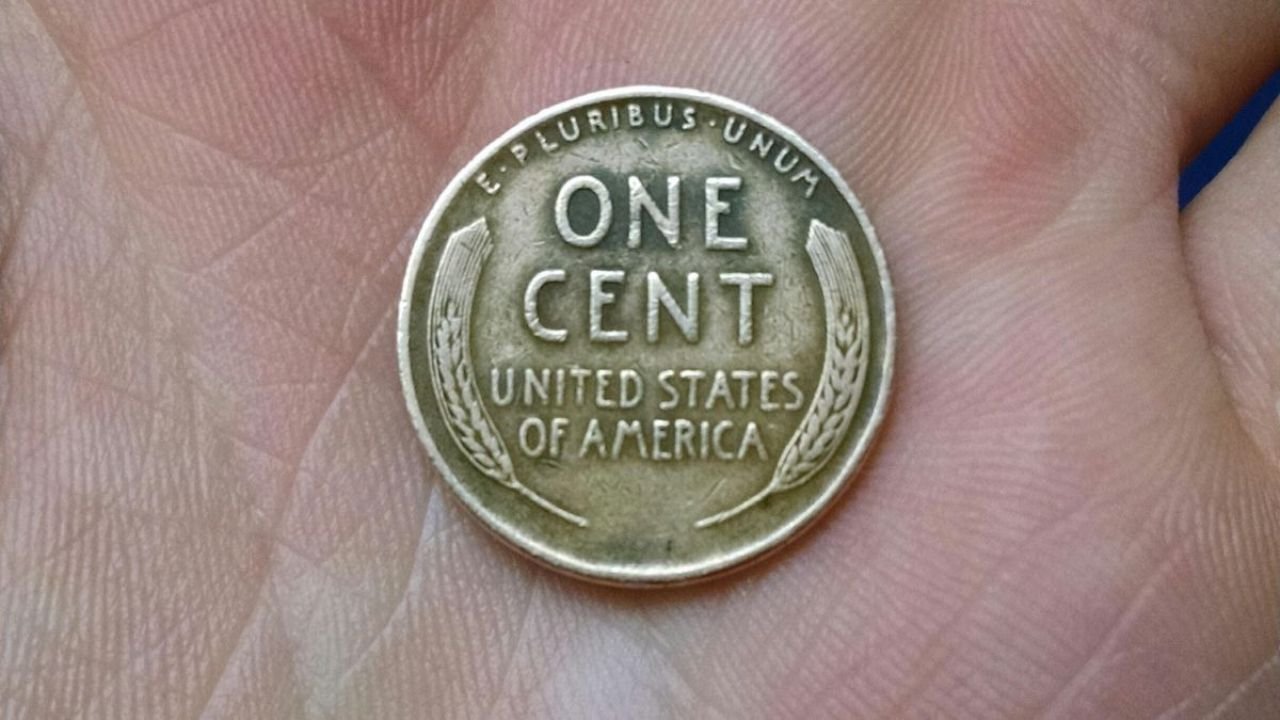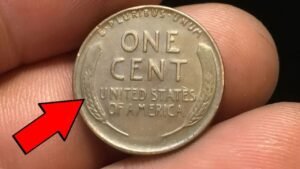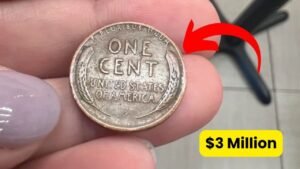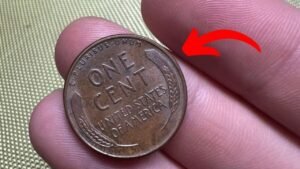A Coin with Historical Significance
The Lincoln Wheat Penny, first minted in 1909, holds a unique place in American history. Designed by Victor David Brenner to celebrate Abraham Lincoln’s 100th birthday, it was the first U.S. coin to feature a real person instead of symbolic figures like Lady Liberty. The obverse showcases Lincoln’s profile, while the reverse displays two wheat stalks framing “ONE CENT.” This iconic design, minted until 1958, is instantly recognizable to collectors and casual coin enthusiasts alike.
The Wartime Mistake That Created a Treasure
The $4.1 million valuation of the 1943 Bronze Lincoln Wheat Penny stems from a rare minting error during World War II. In 1943, copper was critical for war materials like ammunition and telegraph wires. To conserve it, the U.S. Mint switched to zinc-coated steel for pennies, producing the silvery “steelies” familiar to collectors. However, a few bronze planchets from 1942 were accidentally left in the presses and struck with the 1943 date. These mistakes—estimated at only 15 to 20 coins across all U.S. mints—are now among the rarest coins in existence.
Why Is the 1943 Bronze Penny Worth $4.1 Million?
Rarity and Demand Drive Value
With so few 1943 Bronze Pennies known to exist, their scarcity alone makes them highly coveted. According to the Professional Coin Grading Service (PCGS), one pristine specimen sold for $1.7 million in 2010, and market estimates suggest top examples could fetch $4.1 million today due to rising collector demand. The coin’s value is amplified by its pristine condition—mint-state coins with no wear command the highest prices.
Historical Context Adds Allure
The 1943 Bronze Penny isn’t just rare; it’s a tangible piece of WWII history. Its accidental creation during a time of resource scarcity adds a layer of intrigue. “These coins are like time capsules,” says numismatist David Hall, founder of PCGS. “They represent a moment when the U.S. Mint was adapting to wartime challenges, and a tiny error created a numismatic legend.”
Real-Life Discoveries Fuel the Dream
Stories of ordinary people finding these pennies keep the treasure hunt alive. In 1947, a teenager named Don Lutes Jr. received a 1943 Bronze Penny in change at his high school cafeteria. Unaware of its value, he kept it for decades. After his death, the coin was authenticated and sold for $204,000 in 2019. Such stories remind us that these coins could still be out there, hiding in plain sight.
How to Spot a 1943 Bronze Penny
Key Identification Tips
Think you might have a valuable penny? Here’s how to check:
- Date: Look for “1943” on the obverse.
- Color: The rare bronze version has a reddish-brown copper hue, unlike the silvery steel pennies.
- Magnet Test: Steel pennies stick to a magnet; bronze ones don’t.
- Weight: Bronze pennies weigh about 3.11 grams, while steel ones are lighter at 2.7 grams.
Comparing 1943 Pennies
| Feature | 1943 Bronze Penny | 1943 Steel Penny |
|---|---|---|
| Material | Bronze (Copper) | Zinc-Coated Steel |
| Color | Reddish-Brown | Silvery-Gray |
| Magnet Test | Non-Magnetic | Magnetic |
| Weight | ~3.11 grams | ~2.7 grams |
| Estimated Value | Up to $4.1 million | $0.10–$1 (circulated) |
Avoid Counterfeits
Counterfeiters often plate steel pennies with copper or alter dates to mimic the 1943 Bronze Penny. Always consult a professional numismatist or grading service like PCGS or Numismatic Guaranty Corporation (NGC) for authentication. “Never clean a coin,” advises coin expert Laura Sperber. “Cleaning can destroy its value.”
Could a $4.1 Million Penny Still Be in Circulation?
The Thrill of the Hunt
Experts believe a few 1943 Bronze Pennies may still be circulating, tucked away in coin jars, piggy banks, or even vending machine change. Since pennies are often overlooked, these treasures can pass through countless hands unnoticed. In 1981, a New Jersey man found a 1943 Bronze Penny in a roll from his bank, later selling it for $10,000—a modest sum compared to today’s valuations but proof that discoveries happen.
Where to Look
Start with your own change. Check coin rolls from banks, old family collections, or inherited coin jars. Coin shows and flea markets are also great spots to hunt. “I always tell people to look at their pennies twice,” says Ken Potter, a rare coin specialist. “You never know when a million-dollar mistake is staring back at you.”
How to Authenticate and Sell a Rare Penny
Step-by-Step Guide
- Handle with Care: Hold coins by the edges to avoid damaging the surface.
- Use a Magnifying Glass: Examine the date, mint mark, and surface for authenticity.
- Get It Graded: Submit the coin to PCGS or NGC for professional grading.
- Choose a Selling Platform: Options include auction houses like Heritage Auctions, reputable coin dealers, or online marketplaces (with caution).
Market Insights
Auction houses often yield the highest prices for rare coins, though they charge fees. In 2024, rare coin auctions saw a 15% increase in prices due to growing collector interest, according to Stack’s Bowers. For a $4.1 million penny, an auction with global exposure is ideal.
The Bigger Picture: Why Coin Collecting Matters
Coin collecting isn’t just about striking it rich. It’s a way to connect with history, from the artistry of Victor Brenner’s design to the wartime sacrifices reflected in the 1943 penny. Each coin tells a story, whether it’s a common wheat penny or a multi-million-dollar rarity. The hobby also fosters patience and attention to detail—skills that resonate far beyond numismatics.
Inspiring a New Generation
The legend of the $4.1 million penny has sparked renewed interest in coin collecting. Online forums like Reddit’s r/coins and local coin clubs have seen membership spikes as people share finds and tips. “It’s not just about money,” says collector Sarah Thompson. “It’s about holding a piece of the past.”
FAQs About the $4.1 Million Lincoln Wheat Penny
What makes the 1943 Bronze Penny so valuable?
Its value comes from its extreme rarity (only 15–20 exist), historical significance as a WWII minting error, and high demand among collectors.
How can I tell if my 1943 penny is bronze?
Check the date (1943), color (reddish-brown), and do a magnet test. Bronze pennies don’t stick to magnets, unlike steel ones.
Where might I find a 1943 Bronze Penny?
Look in pocket change, bank rolls, old collections, or at coin shows. Some have been found in everyday transactions.
How do I authenticate a rare penny?
Contact a professional grading service like PCGS or NGC. Never clean the coin, as this can reduce its value.
Can I sell a rare penny myself?
Yes, through auction houses, coin dealers, or online platforms. Auctions typically fetch the highest prices for rare coins.
Conclusion: Start Your Treasure Hunt Today
The $4.1 million Lincoln Wheat Penny is more than a coin—it’s a reminder that extraordinary value can hide in the ordinary. Whether you’re a seasoned collector or just curious, take a moment to check your change. That penny in your pocket could be a life-changing discovery. So, grab a magnifying glass, test those 1943 pennies, and join the treasure hunt. Who knows? You might just find a piece of history worth millions.




